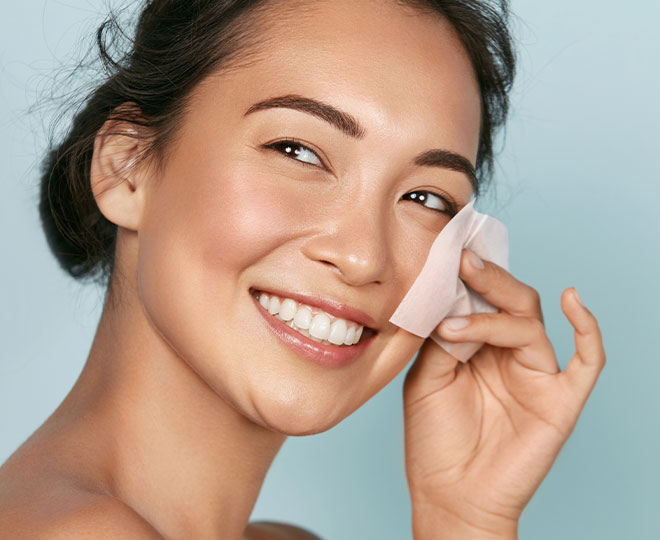Do you often find your t-zone looks a bit greasy? Maybe you’re constantly battling unwanted shine. One of the main skin dilemmas dermatologists and makeup artists alike are faced with is, how to get rid of oily skin. Greasy, shiny skin is a result of your sebaceous glands producing extra sebum (oil), and there are many reasons this may happen whether you’re prone to having an oily skin type or not. Of course, blotting papers can help temporarily stop oily skin, but we recommend getting to the root of the issue, starting with understanding your skin’s needs and making your skincare regimen a priority.
To make sure your skin truly is oily, identify your skin type by washing your face with a gentle cleanser and not applying any of your other skincare products. Wait a while after washing and examine your natural skin texture and tone closely. If you look in the mirror and see that your skin is shiny, you have oily skin. If your face is red, flaky, tight, or irritated, you have dry skin. If you find you have patches of shine and patches of irritation or redness, then you have combination skin.
If you have oily skin, your sebaceous glands are producing too much sebum and can often leave an oily film on top of your skin. This can also lead to clogged pores and acne. As a matter of fact, the more active your oil glands are, the bigger your pores will appear. However, there are also benefits to having oily skin – it helps to preserve your skin and can lead to fewer wrinkles later in life. Here are some tips on how to treat your oily skin.
Use a cleanser with benzoyl peroxide
Benzoyl peroxide (also known as BP or BPO) is a topical antibacterial treatment that is great for oily skin types. It works quickly to fight acne-causing bacteria by delivering oxygen into your pores and helps to unclog them. Consider using a cleanser with benzoyl peroxide twice a day, morning and night.
Exfoliate
Exfoliating oily skin is imperative but can also be tricky. Because oily skin is also acne prone, it’s important you choose an exfoliator that won’t irritate any breakouts you may have. Believe it or not, exfoliating too much can make your skin even more oily. It’s all about balance.
Don't forget sunscreen
If your skin feels greasy you might think you can skip applying sunscreen, but using sunscreen is important for all skin types. Yes, even when you’re trying to treat oily skin. Good news is – there are plenty of oil-free sunscreens to choose from that won’t add to the unwanted, greasy film on top of your skin. As a matter of fact, some help to take it away all together. Look for a lightweight, oil free, mattifying sunscreen with SPF 30 or higher every day to help prevent sun damage from UVA and UVB rays and keep your oily skin in check.
Use the right moisturizer
Your gut instinct may be to skip your moisturizer since it seems you have enough oil on your skin, but in fact, using moisturizer is still an important step in your skincare regimen. There’s a difference between hydrated skin and oily skin. When your skin is hydrated, water is absorbed into your epidermis to maintain elasticity. However, oil helps to maintain your skin’s barrier function. Therefore, the right moisturizer will help to keep your excess oil under control instead of adding to the greasy film. A gentle hydrator is a great place to start.
Choose smart makeup formulas
Part of the struggle with having oily skin is keeping your makeup from sliding off your face. Sound familiar? Face makeup like foundation and concealer emulsify quickly when it mixes with natural oils, which can leave you with creases or a messy finish about an hour or two after application. To prevent this, choose your formulas wisely. Instead of using a primer all over your face, use a mattifying primer specifically on the oily areas. Opt for an oil-free non-comedogenic foundation, and skip powder bronzer, blush and eyeshadow if you can. Cream and jelly-like textures work better on oily skin.
The takeaway
After reading this piece, we hope you’re able to understand what might be causing your oily skin. Just a few strategic skincare moves and the right products for your skin type will make a big difference. When it comes to skincare, remember patience is key. It takes time for your skin to adapt to a new regimen so be patient with yourself – and your skin.






